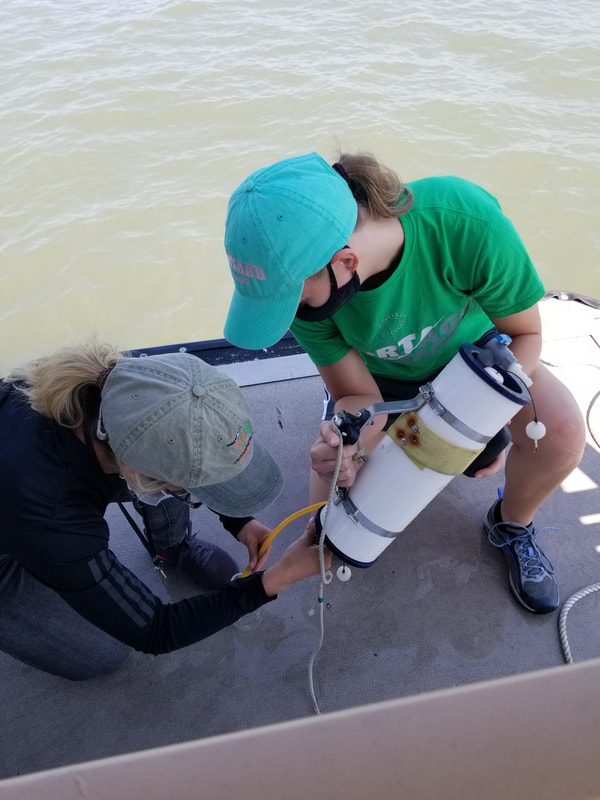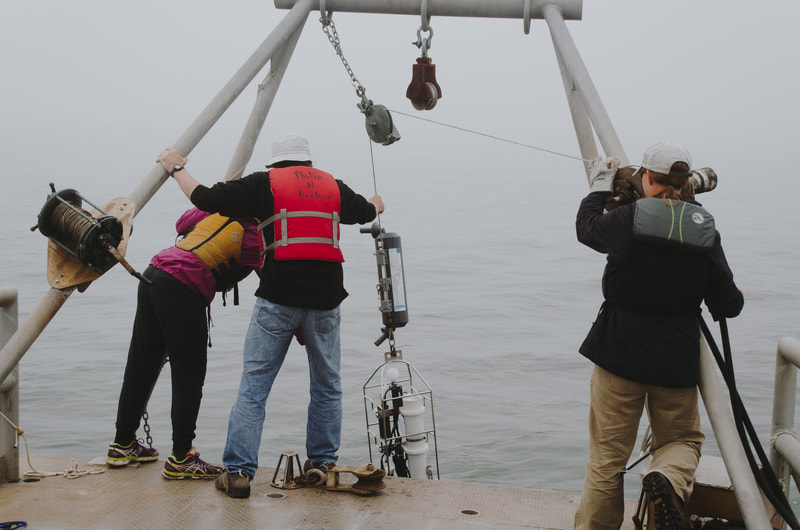Biological Oceanography - ESCI 465/BIOL 495
Dr. Robert Vaillancourt - Millersville University
Class is full! You may still register for the course but you will be put on the waitlist. If you are put on the waitlist you will not be asked to pay the deposit unless you are put in the class. We will send an email to the next person on the roster if someone decides to drop the class. Thank you!
Course Description:
The physical, chemical, optical, and biological factors controlling the structure of marine populations and the dynamics of marine ecosystems. Theoretical principles concerning the growth and maintenance of phytoplankton populations in the surface ocean, and its relation to nutrients and sunlight penetration. The dynamics and complexity of marine food webs and ecosystem structure, animal and plant adaptations to the environment, zooplankton life-cycles and feeding behaviors, and marine fish population dynamics. The laboratory and field component will focus on ocean sampling and seawater analysis for purposes of ocean monitoring of important physical, biological, optical, and chemical parameters, including plankton biomass using extracted and in-vivo fluorescence techniques, rates of net and gross primary production using oxygen light-dark bottle experiments, underwater sunlight attenuation and penetration, gas concentrations using in-water sensors and chemical titrations, and optical and gravimetric determinations of seawater turbidity. The laboratory and field component teaches skills that can be immediately applied in graduate school or technical jobs in environmental monitoring.
Marketable Skills Gained from This Course:
General Description of Field Activities:
We will take several trips for field sampling and measurements aboard research vessels on Chincoteague Bay and/or the mid-Atlantic bight continental shelf, depending on sea state and weather. Boat trips will be between 2 and 5 hours duration.
Prerequisites:
One semester of college level oceanography or marine biology and one semester of college biology (or both can be satisfied by one 200-level marine bio course)
Required Textbook or Supplies:
Biological Oceanography, An Introduction, 2nd Ed. 2006. C.M. Lalli and T.R. Parsons, Elsevier Press, Burlington, MA, 307 pp. (ISBN: 0-7506-3384-0)
Light foul-weather gear (pants and jacket) and sun protective gear (hat, sunglasses, etc) highly encouraged. Pair of sturdy boat shoes (must cover foot entirely; no sandals on boats!).
Number of Students:
9-16
2023 Chincoteague Bay Field Station Fee*:
3 week course; housing and meals included
Salicornia; $1,692
Traditional; $1,542
Fees are subject to change at the discretion of the board of directors
* Does not include university tuition or fees. For specific policy on CBFS fees, click HERE.
Course Description:
The physical, chemical, optical, and biological factors controlling the structure of marine populations and the dynamics of marine ecosystems. Theoretical principles concerning the growth and maintenance of phytoplankton populations in the surface ocean, and its relation to nutrients and sunlight penetration. The dynamics and complexity of marine food webs and ecosystem structure, animal and plant adaptations to the environment, zooplankton life-cycles and feeding behaviors, and marine fish population dynamics. The laboratory and field component will focus on ocean sampling and seawater analysis for purposes of ocean monitoring of important physical, biological, optical, and chemical parameters, including plankton biomass using extracted and in-vivo fluorescence techniques, rates of net and gross primary production using oxygen light-dark bottle experiments, underwater sunlight attenuation and penetration, gas concentrations using in-water sensors and chemical titrations, and optical and gravimetric determinations of seawater turbidity. The laboratory and field component teaches skills that can be immediately applied in graduate school or technical jobs in environmental monitoring.
Marketable Skills Gained from This Course:
- Ocean sampling from boats
- CTD deployment and recovery and data analysis
- Plotting and analysis techniques for hydrographic data
- Measurement of the following parameters:
- Chlorophyll a by chemical solvent extraction and fluorescence
- Oxygen concentration by Winkler titration and polargraphic electrode
- Sunlight intensity using submersible light meters; calculation of attenuation coefficient from light profiles
- Water transparency using Secchi disk
- Oxygen, temperature and salinity profiles using YSI hand-held meters
- Plankton net hauls and quantitative measure of plankton biomass
- Plankton microscopic identification and enumeration
- Primary production by light-dark bottle incubation
- Oral presentation skills
- Plotting and data analysis of oceanographic data using Ocean Data View and Microsoft Excel software.
General Description of Field Activities:
We will take several trips for field sampling and measurements aboard research vessels on Chincoteague Bay and/or the mid-Atlantic bight continental shelf, depending on sea state and weather. Boat trips will be between 2 and 5 hours duration.
Prerequisites:
One semester of college level oceanography or marine biology and one semester of college biology (or both can be satisfied by one 200-level marine bio course)
Required Textbook or Supplies:
Biological Oceanography, An Introduction, 2nd Ed. 2006. C.M. Lalli and T.R. Parsons, Elsevier Press, Burlington, MA, 307 pp. (ISBN: 0-7506-3384-0)
Light foul-weather gear (pants and jacket) and sun protective gear (hat, sunglasses, etc) highly encouraged. Pair of sturdy boat shoes (must cover foot entirely; no sandals on boats!).
Number of Students:
9-16
2023 Chincoteague Bay Field Station Fee*:
3 week course; housing and meals included
Salicornia; $1,692
Traditional; $1,542
Fees are subject to change at the discretion of the board of directors
* Does not include university tuition or fees. For specific policy on CBFS fees, click HERE.




